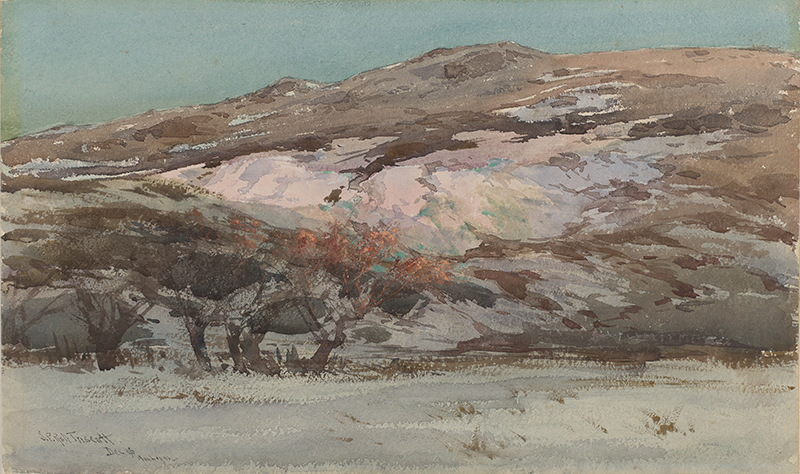Object of the Month: “Monhegan Winter” by Samuel Peter RoltTriscott
By Bowdoin College Museum of Art
Monhegan Winter, 1896, watercolor by Samuel Peter Rolt Triscott, British, 1846–1925. Gift of Gift of Stephen H. Israel. Bowdoin College Museum of Art.
This watercolor, done in 1896 by artist Samuel Peter Rolt Triscott, depicts a barren rocky outcropping on Monhegan Island. Born in England in 1846, Triscott received formal training at the Royal Institute of Painters in Watercolors in London, before coming to the United States in 1871 and settling in Worcester, Massachusetts. Triscott began visiting Monhegan and eventually established a residence there in the 1890s. He originally stayed at the Albee House, advertised as an “artists paradise." He developed a love and fascination with Monhegan and eventually bought his own house on the island. The winter setting of this painting illustrates Triscott’s rich commitment to and engagement with the island, documenting a lesser-seen view of the landscape, as many artists and other Monhegan visitors spent only the summers on the Island.
Triscott’s watercolor will be part of an upcoming exhibition at the Bowdoin College Museum of Art, developed collaboratively between Frank Goodyear, co-director, Barry Logan, Samuel S. Butcher Professor in the Natural Sciences, and Jennifer Pye, director of the Monhegan Museum of Art and History. Logan has been studying the rich ecological history of Monhegan for the last twenty years. Particularly noteworthy is the fact that this is a history marked by change. Human development and agriculture, the introduction of white tail deer, and the spread of mistletoe parasite have all had significant effects on the composition and density of the forests on Monhegan. In researching this project, organizers of the exhibition were interested in the connection between Monhegan’s artistic and ecological histories. As Barry Logan describes, “some of the nation’s finest landscape painters have portrayed the island, and it occurred to me that these artists, through their work, may be able to inform the work of scientists such as myself.” This connection between science and art served as the inspiration for the upcoming exhibit.
This particular work by Triscott is especially interesting in the context of this exhibit, as the date of its creation coincides with the removal of the last sheep from Monhegan Island. Sheep were originally brought to the Island in the early nineteenth century. To create pastures for sheep, the islanders cleared away a large amount of the original forest, greatly changing the ecological makeup of the island. Sheep lived on Monhegan for about fifty years before concerns of animal abuse were raised. This suspected abuse was reported to the Maine State Society for the Protection of Animals (MSSPA). The MSSPA sent an agent to the island in 1896, who concurred with the report that the animals were not being given proper shelter or food to survive the harsh island winters. The Supreme Judicial Court of Lincoln County ruled in favor of the MSSPA and ordered all the sheep to be removed by 1896. This effectively ended the era of sheep pastures on Monhegan. The wintry landscape that Triscott pictures in this watercolor captures the same harsh landscape that was at the heart of the debate in the fight over sheep on Monhegan. This story is one of the many that brings together the ecological history of Monhegan with the the island's artistic history.
Silas Brown ’24Student Assistant to the Curator
Bowdoin College Museum of Art